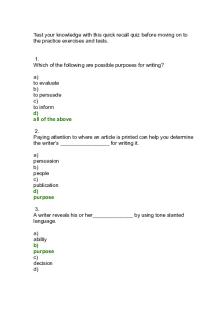Theory For Vocal Tone PDF

| Title | Theory For Vocal Tone |
|---|---|
| Author | Stephen Jesuthasan |
| Course | Drama |
| Institution | Higher School Certificate (New South Wales) |
| Pages | 1 |
| File Size | 31.6 KB |
| File Type | |
| Total Downloads | 31 |
| Total Views | 157 |
Summary
Download Theory For Vocal Tone PDF
Description
1.How to develop a pleasing vocal quality? The voice is a pivotal part of everyday life in the 21st century as we use it to convey ideas, converse and to produce opinions. As the voice is so important having a pleasing vocal quality is even more important as it can decide how an idea is being presented. For example, in the workplace having a strong voice and a pleasing vocal quality can grab attention and creates a large advantage to someone with a weak voice that is not pleasing. The three main factors to creating a pleasing vocal quality. These factors include pitch, volume and speed. The pitch of the voice is critical. This is because when pitch is used too low or too high it can lead people to mishear your words or believe that you are mocking. A common reason for pitch being too high is having a nasal voice. A nasal voice is caused when the individuals voice only resonates in the nose. Another voice that effects someone’s vocal quality is a mouth voice. A mouth voice is a voice that does not produce much sound so people who use this voice are at a disadvantage as they are usually not heard or paid attention to in comparison to others. The main cause of these issues is the breathing method. The correct breathing method is called the intercostal diaphragmatic breathing method. In the rib cage there is a muscle called the intercostal muscle that allows the ribs to move allowing the lungs to expand more. The diaphragm is the large muscle that will flatten to allow the lungs to expand for maximum breath control. Using this breathing method will create a stronger and more appealing voice. When speaking, pitch can be used to indicate the tone of the story. For example, when reading a sombre text, the reader may lower his/her voice to meet the tone of the texts. Another vital factor of speech is volume. Having a volume that is too high can cause someone to be startled or you can become hard to listen to. On the other hand, having a volume that is too low can make your words hard to follow or make you misheard. As with many things the best way to improve is to practise. The most efficient way to do this is to practise in front of a mirror or with another person listening to you. When doing this you can critique yourself or be critiqued when speaking too loud or too soft. After doing this for a while, you will begin to have a more appealing volume to your voice. When used correctly, volume can be used for onomatopoeia and shouting or whispering during text. The third aspect of vocal quality is speed. Speed dictates how easy the play is to follow. Reading too fast may cause your words to be misheard whilst speaking too slowly may become monotonous to listeners. The most common example of speed being a problem with speakers is when a speaker is very nervous which makes them read extremely fast out of nervousness. To combat this again practising reading in front of a few people can greatly help your struggle. Whilst using speed the speaker can generate tension or enthusiasm in his/her speech. To conclude, when done correctly the speaker would have developed a pleasing vocal quality after perfecting their volume, speed and pitch....
Similar Free PDFs

Theory For Vocal Tone
- 1 Pages

Higiene Vocal
- 2 Pages

Tone words - english
- 6 Pages

02. Evaluación Vocal
- 3 Pages

Vocal EQ Cheat codes
- 11 Pages

Purpose and Tone
- 18 Pages

Identifying Tone Activity 1
- 5 Pages

Diction, Syntax, and Tone
- 3 Pages

Vocal Tract Tongue Face Muscles
- 10 Pages

MUSIC THEORY FOR DUMNNIES
- 364 Pages

Manual de canto tecnica vocal
- 24 Pages

O beabá da técnica vocal
- 21 Pages

Tone word list and definitions
- 9 Pages
Popular Institutions
- Tinajero National High School - Annex
- Politeknik Caltex Riau
- Yokohama City University
- SGT University
- University of Al-Qadisiyah
- Divine Word College of Vigan
- Techniek College Rotterdam
- Universidade de Santiago
- Universiti Teknologi MARA Cawangan Johor Kampus Pasir Gudang
- Poltekkes Kemenkes Yogyakarta
- Baguio City National High School
- Colegio san marcos
- preparatoria uno
- Centro de Bachillerato Tecnológico Industrial y de Servicios No. 107
- Dalian Maritime University
- Quang Trung Secondary School
- Colegio Tecnológico en Informática
- Corporación Regional de Educación Superior
- Grupo CEDVA
- Dar Al Uloom University
- Centro de Estudios Preuniversitarios de la Universidad Nacional de Ingeniería
- 上智大学
- Aakash International School, Nuna Majara
- San Felipe Neri Catholic School
- Kang Chiao International School - New Taipei City
- Misamis Occidental National High School
- Institución Educativa Escuela Normal Juan Ladrilleros
- Kolehiyo ng Pantukan
- Batanes State College
- Instituto Continental
- Sekolah Menengah Kejuruan Kesehatan Kaltara (Tarakan)
- Colegio de La Inmaculada Concepcion - Cebu


